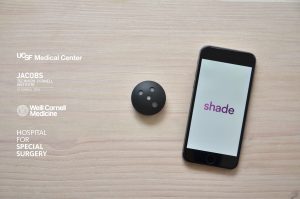Wearable UV Sensor, Shade, May Offer Lupus Patients Way of Controlling Symptoms

Researchers at the biotechnology company Shade have developed a sensor, going under the same name, that allows people with systemic lupus erythematosus to accurately measure their ultraviolet (UV) exposure, enabling them to find and adjust to the personal exposure threshold that triggers their symptoms.
While many wearable devices claim to measure vital signs, Shade — developed by researchers — is reported to be as accurate and sensitive as significantly more expensive laboratory equipment.
“Today, there is a large gap in terms of reliability and accuracy between affordable consumer devices and expensive scientific laboratory equipment,” Emmanuel Dumont, PhD, a biophysicist, and the founder and CEO of Shade, said in a release provided to Lupus News Today. “Shade’s technology bridges this gap.”
The sensor was invented by scientists at the Jacobs Technion-Cornell Institute in New York, who worked with the design and innovation consultancy IDEO to develop the tracker. Several lupus patients were involved in the team beta testing Shade, and positive results are overwhelmingly positive.
Lupus is a disease where symptoms can be triggered by environmental factors, such as infections, smoking, and UV radiation. But while it is possible to quit smoking and take measures to prevent getting sick, it is difficult to completely stay out of the sun.
Patients also differ in their individual tolerance to UV light, and so far, there has been no reliable way to measure exposure. Symptoms triggered by UV also tend to be delayed by hours or days, making UV light is one of the environmental factors most difficult to control. Dumont decided to change that.
“Patients need to keep track of their cumulative UV exposure over the day, an arduous task given the high variations of UV exposure inside a car, in the shade, in direct sunlight,” she said.
Shade is a round, flat sensor that attaches to an outer garment with magnets. The sensor is linked with Bluetooth to an application on the patient’s smartphone, and automatically collects data throughout the day.
Each day, users also reports how they are feeling on a 10-point scale. The UV and patient data are displayed side by side, and patients can decide how much UV exposure they wish to manage. This cut-off value is then sent back to the sensor. According to Dumont, it takes one to two weeks before users find their personal UV tolerance.
One of the beta-users of Shade was U.S. Olympic gold medalist Shannon Boxx, who was also on the winning team of the soccer World Cup in 2015.
“With lupus, just training outdoors was often detrimental,” said Boxx, who was fighting her lupus while training for the championship. “Shade has helped me pinpoint and manage my personal tolerance to UV. For the first time, I feel confident and in control of my lupus.”
The medical board working with Dumont to develop the sensor included researchers such as Dr. Gary Gikelson, chairman of the Council of the Lupus Foundation of America.
Dr. Alana Levine, another member of the board and a rheumatologist at Hospital for Special Surgery in New York, speaks highly of the new sensor. ”Shade is a breakthrough, placing an accurate measuring device into the hands of the patient, and it enables patients to understand how much UV exposure triggers their own symptoms.”
Shade sensors will be available for order at wearshade.com and will start shipping in November. You can watch a Shade product video below.







